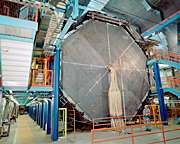New results confirm standard neutrino theory

(PhysOrg.com) -- In its search for a better understanding of the mysterious neutrinos, a group of experimenters at DOE’s Fermi National Accelerator Laboratory has announced results that confirm the theory of neutrino oscillations and help rule out two alternative scenarios: neutrino decay and the existence of sterile neutrinos.
The Main Injector Neutrino Oscillation Search experiment, or MINOS, explores the properties of muon neutrinos produced at Fermilab. When sending a beam of neutrinos 735 kilometers through the earth to a neutrino detector in the Soudan Underground Laboratory in Soudan, Minn., scientists find that a significant fraction of the muon neutrinos disappears along the journey. The standard explanation is that the missing muon neutrinos morph into two other known types of neutrinos: electron neutrinos and tau neutrinos. This process is known as neutrino oscillations or neutrino mixing.
But could there be another explanation? Scientists are exploring alternatives such as the decay of muon neutrinos into yet-to-be discovered particles or the transformation of muon neutrinos into a fourth type of neutrino, which is often called a sterile neutrino since it would not interact with ordinary matter like the other three known types of neutrinos.
MINOS scientists found that neutrino decay is an unlikely option. They looked at two scenarios: First, the possibility that no neutrino oscillations take place and hence all muon neutrinos decay. Second, they considered the possibility that some muon neutrinos transform into other neutrinos and some decay during their trip from Fermilab to Soudan, which takes about four hundredths of a second. In both analyses, the MINOS results provide strong evidence against the existence of neutrino decay.
The MINOS results also disfavor the existence of a fourth, sterile neutrino. Past analyses have shown that if muon neutrinos are oscillating into sterile neutrinos, only 68 percent of the disappearing neutrinos can do so. The new MINOS analysis shrinks that percentage to 50 percent, and future MINOS data are expected to reduce it further.
The MINOS collaboration submitted its results to Physical Review D.
More information: www-numi.fnal.gov/PublicInfo/index.html
Provided by Fermi National Accelerator Laboratory
















